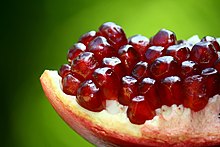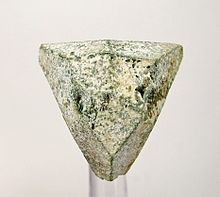Garnet
![]()
Garnet is a redirect to this article. See also Garnet (disambiguation).
The garnet group (short garnets) is an important group of rock-forming minerals from the division of the island silicates (nesosilicates).
The general granular formula is: [8]X3[6]Y2[[4]ZO4]3 or also A32+B23+[RO4]3, where 'X', 'Y' and 'Z' or 'A', 'B' and 'R', however, do not represent chemical elements but represent defined places in the crystal lattice. The respective lattice sites can be occupied by different ions:
- X or A: predominantly divalent cations, dodecahedrally surrounded by eight oxygen anions, mostly Mg2+, Fe2+, Mn2+ and Ca2+ but also Y3+ or Na+.
- Y or B: predominantly trivalent cations, octahedrally surrounded by six oxygen anions, mostly Al3+, Fe3+, Cr3+ and V3+, but also Ti4+, Zr4+, Sn4+, Sb5+ or Mg2+, Mn2+.
- Z or R: predominantly tetravalent cations surrounded by four oxygen anions, mostly Si4+, but also Al3+, Fe3+, Ti4+, P5+, As5+, V5+.
- Anion: mostly O2-, rarely also (OH)- or F-
Within the garnet upper group, to which all minerals are counted that crystallize with the garnet structure, also those from other mineral classes (e.g. halides, hydroxides), the garnet group summarizes all minerals with 12 positive charges per formula unit on the Z-position. Currently (2013), these are only silicates.
The garnet minerals crystallize mostly in the cubic crystal system and form predominantly isometric crystals with the characteristic forms of the rhombic dodecahedron (outdated also garnet dodecahedron), icosite tetrahedron as well as their combinations.
Garnets are generally transparent to translucent, with many foreign admixtures and in coarse mineral aggregates also opaque. Uninjured or unweathered crystal faces exhibit a glassy to greasy luster. The colour of the garnets is very variable, even if reddish colour varieties predominate. The palette ranges from a light green to yellow-green to dark green, light yellow to yellow-orange and orange-red as well as from a light pink to an almost black-looking dark red. Rarer are colourless and brown varieties and very rarely colour-changing (iridescent) and blue garnets. However, the line colour is always white.
Their relatively high density (3.5 to 4.5 g/cm3), Mohs hardness (6.5 to 7.5) and light refraction (n = 1.61 (catoite) to n = 1.96 (calderite)) make them interesting both as gemstones and for industrial applications.
Etymology and history
The term garnet was first coined in the Middle Ages, but has its origins in the Latin word granum for grain or kernel or granatus for granular or rich in kernels and refers on the one hand to the occurrence of the mineral in grains, which have similarities with the kernels of the pomegranate (Punica granatum), but on the other hand also to the orange-red to red-violet colour of the blossom, fruit and kernels of the pomegranate.
Garnets were already used as gemstones in ancient times. In the Middle Ages, together with rubies and spinels, they were known as carbuncle (also known as carbuncle stone) - most of them came from India at that time. Under the horn of the mythical creature unicorn, a carbuncle stone growing there was believed to be able to heal all wounds. But they were particularly popular in the 19th century, when Bohemian pyrope were so sought after that they were shipped as far as America.

compared to a garnet mineral specimen

Opened fruit of the pomegranate
Modifications and varieties
- Achtaragdite (also Achtarandite, English Akhtaragdite): Pseudomorph of Grossular-Katoite-mixed crystals (Hydrogrossular) after mineral of the Mayenit-Obergruppe, possibly also from Hibschit after Wadalit of the Wiljui in Russia. Achtaragdite is usually found in the form of tetrahedral or triakistetrahedral crystals of white-gray to gray-brown color.
- Bredbergite (after James Dwight Dana, around 1900): Obsolete and no longer common name for a magnesium-rich andradite variety.
- Demantoid (after Nils von Nordenskiöld, c. 1870): Andradite variety coloured yellow-green by foreign admixtures.
- Melanite (after Abraham Gottlob Werner, 1799): Considered a titanium-rich variety of andradite and named after the Greek word μέλας for black, as it occurs predominantly in gray-black to pitch-black crystals or coarse aggregates.
- Topazolite (after P. C. Bonvoisin, 1806): Light yellow, "topaz-like" andradite variety, first discovered in the Valle di Lanza in the Italian region of Piedmont.
- Xalostocite: Name for a dense intergrowth of translucent pink grossulars with white marble, named after the locality of Xalostoc in the Mexican state of Morelos.

Eight-aragmite from the Akhtaragda River mouth, Vilyui Basin, Russia (size: 2,5 × 2,4 × 1,5 cm)
Search within the encyclopedia